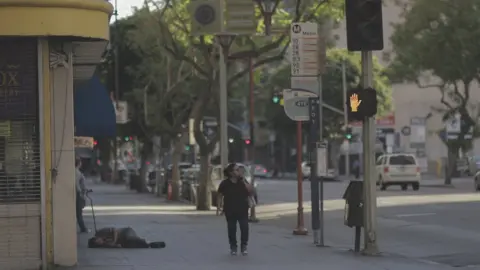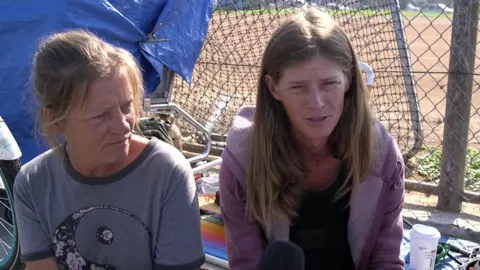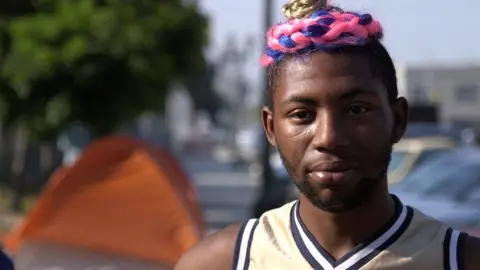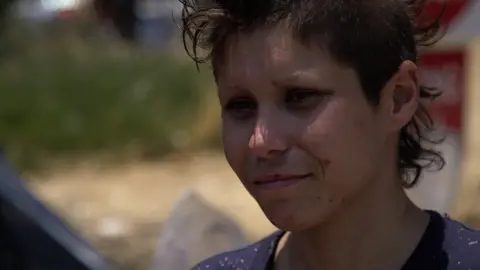Los Angeles' homeless crisis goes from bad to worse
 Stephen Adrain
Stephen AdrainLos Angeles' entertainment industry nurtures the city's dreamy La La Land image. But while Hollywood laps up the attention, there is a growing crisis in the land of make-believe - a soaring increase in the number of homeless people living on its streets.
Homelessness in Los Angeles County soared by 23% in the past year and it shows. The problem has become tangible and inescapable, with makeshift tent encampments cropping up across the sprawling metropolis.
Tourists are shocked to find themselves stepping over people draped in filthy blankets and begging on Hollywood's Walk of Fame. Shop owners routinely swill the pavements to wash away urine and the accompanying stench.
"For the 31 years that I've been involved with homelessness... it has gotten worse far worse than I've ever seen before," says Ted Hayes, a long-time activist.
Hayes says gentrification of the downtown area has begun to scatter a previously concentrated homeless population across the city.
The yearly homeless count in Los Angeles County rose to 58,000 in 2017, up from 46,874 in 2016.
Neighbouring areas, such as Orange County, are also experiencing the same upwards trend.
 Getty Images
Getty ImagesThe count was compiled by a team of 7,700 volunteers over three days and three nights in January.
Young people - aged 18-24 - are the fastest growing group of homeless people, up 64%. And children without a home increased 41%
"Those numbers were stunning," says Kerry Morrison, executive director of the Hollywood Property Owners Alliance.
With an office on a seedy stretch of Hollywood Boulevard, Morrison says local business owners - along with city officials and myriad charitable organisations - have been working on the issue for years. But they appear to be losing the battle.
"Something is shifting right now, we're all noticing it," she says. "We could viscerally feel that something was changing maybe about two years ago."
Morrison believes the problem has worsened because of combination of factors, with rising housing costs in the city at the top of that list.
"The cost of housing is far outpacing the increase in incomes."
Another potential factor is California's drive to reduce the prison population. The state has committed to new rules that mean nearly 9,500 people will be released early. Morrison believes that in some cases, they also end up on the streets.
There's also what she describes as the "attraction" of the Golden State to Americans who find themselves in dire economic circumstances.
"California seems to have this allure," she says. "'Go west and stake your claim. Make your future here.'"
Kitty and her 34-year-old daughter, Sura, who I met on a side street in Hollywood, saw California as a respite from difficult times.
 Stephen Adrain
Stephen AdrainOriginally from Nevada, they moved first to Idaho, where they lost their jobs, and then to Arizona and eventually to California hoping to "start over".
Sura, who is transgender, says they choose to stay in Hollywood because the local LGBT centre is "really great".
Weather-beaten by the intense California sun, they live under canvas by night and spend time in local libraries during the day, mainly so that they can charge their mobile phones.
But living on the streets was never part of the plan.
"We couldn't find work and couldn't pay rent so we just ended up homeless," says Kitty.
They're not alone, says Tom Waldman of the LA Homeless Services Authority.
"People are attracted to Los Angeles County because of the climate and because it is a world class city… they come here and they find themselves in situations where it's just too expensive to live on a month-to-month basis."
He too blames "the economic conditions that are prevailing in the city right now around rents and the very high poverty rate".
Kay, a vulnerable-looking 20-year old, lives in a tent with his friends in Hollywood. He wants to be a star.
"I want to be famous - I want to do music and dance," he says.
 Stephen Adrain
Stephen AdrainBut life on the streets is "stressful", he says.
"There's a lot of things out here that are not for me, like drugs. It can be very hard being able to say no."
Like many young homeless people, Kay says he prefers to sleep rough than move into a shelter, because he worries about hygiene issues. He says Skid Row, Los Angeles's notorious and largest homeless enclave, is a "scary" place.
Homelessness in Los Angeles County is "paradoxical", says Waldman.
He points out that more than 14,000 people were moved into permanent or transitional housing last year, a 30% increase from 2015.
"In one sense we're doing our job better," he says, but the overall problem is getting worse.
There is no shortage of goodwill to try to resolve it. State legislators are looking at new measures to kick-start the building of affordable housing. In March, voters approved a tax increase, to pay for rent subsidies and services for the homeless.
It means an extra $355m (£272m) will be spent every year, for the next 10 years, on shelters, rehabilitation facilities and services. Last year, another ballot measure secured $1.2bn in funding for permanent housing.
"At the same time that we have this population rising so dramatically the voters have given us the resources to attack it," says Waldman, adding his agency is "excited" to use the funding to reduce the number of people sleeping rough.
While city officials are optimistic that they now have the tools and financial backing to make a difference, others are less enthusiastic.
"What I watched over the years is a greater deterioration in the approach to homelessness, it's insane," says Hayes, who is sceptical that the current financial windfall will do much to help.
"The more money they raise the worse the problem becomes, so obviously the money is not getting to the people on the streets."
The Hollywood freeway snakes through town, connecting hidden communities and tourist destinations, under the gaze of the famous Hollywood sign.
Living in squalid conditions, at the edge of an off-ramp of the motorway, Christin, 26, is well aware of the dichotomy facing Los Angeles.
 Stephen Adrain
Stephen Adrain"You'd think of some expensive place, clean - you wouldn't expect people on every corner, clothes everywhere - trash."
"People come here to make their dreams come true. I don't think they do that so much anymore."
What about your own dreams? I ask.
"Yeah I want to sing. Actually, I don't know that will happen out here."
